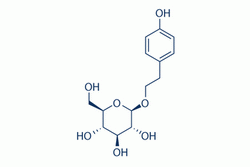| Cas No.: | 10338-51-9 |
| SMILES: | O[C@H]([C@H]([C@@H]([C@@H](CO)O1)O)O)[C@@H]1OCCC2=CC=C(O)C=C2 |
| Formula: | C14H20O7 |
| M.Wt: | 300.3 |
| Purity: | >98% |
| Sotrage: | 2 years -20°C Powder, 2 weeks 4°C in DMSO, 6 months -80°C in DMSO |
| Description: | Salidroside is a prolyl endopeptidase Inhibitor. Salidroside alleviates cachexia symptoms in mouse models of cancer cachexia via activating mTOR signalling. |
| Target: | mTOR |
| In Vivo: | Salidroside is a natural antioxidant extracted from medicinal food plant Rhodiola rosea. Salidroside (100 mg/kg/day) shows strong glucose lowering effect on db/db mice which is similar to effect of Metformin (200 mg/kg/day). For this reason, the dose of 100 mg/kg/day salidroside is used[4]. |
| In Vitro: | Salidroside (100 μM) inhibits prolyl endopeptidase (PEP) activity (10.6±1.9%). Prolyl endopeptidase is an enzyme that plays a role in the metabolism of proline-containing neuropeptidase which is recognized to be involved in learning and memory[1]. Salidroside, one of the major phenylpropanoid glycosides found in R. rosea L, is consumed almost daily as a nutritional supplement in many countries and has been identified possessing potential anti-fatigue and anoxia,anti-aging, and anti-Alzheimer's disease activities. Salidroside can improve muscle nutrition via increasing mTOR, p-mTOR, and MyHC expression[2]. SH-SY5Y cells are exposed to 0-600 μM MPP+ for 12-48 h and the results show that MPP+ results in a significant decrease of cell viability in a concentration and time-dependent manner. Cells are pretreated with 25-100 μM Salidroside (Sal) for 24 h and then exposed to 500 μM MPP+ for an additional 24 h. Salidroside concentration-dependently prevents MPP+-induced decrease of cell viability. Annexin V/PI staining is a common method for the detection of apoptotic cell. Salidroside significantly decreases the number of Annexin V/PI-stained cells treated by MPP+ which is in a concentration-dependent manner. Apoptotic cell could also be morphologically evaluated by Hoechst staining. In Hoechst staining, apoptotic cells are characterized by reduced nuclear size, chromatin condensation, intense fluorescence, and nuclear fragmentation. Salidroside notably inhibits MPP+-induced increase of chromatin condensation, intense fluorescence, and nuclear fragmentation in SH-SY5Y cells[3]. |
| Cell Assay: | SH-SY5Y cells are seeded in 96-well plates at 1×104 cells per well. After the treatment with Salidroside (25-100 μM) and MPP+, cell viability is measured by MTT assay. Briefly, cells are incubated with 500 μg/mL MTT at 37°C for 4 h. After that, the medium is removed and 150 μL DMSO is added and shaking is conducted for 10 min. Absorbance is measured at 570 nm in a microplate reader and the results are expressed as folds of control[3]. |
| Animal Administration: | Mice[4] The 4-week-old male C57BL/6 mice are fed a high-fat diet (HFD) (n=16) or normal chow diet (n=8). After 10 weeks of the HFD, salidroside intervention (100 mg/kg/day) is initiated by gavage once a day for 5 weeks. The control groups are given vehicle (saline). The 4-week-old male C57Bl/KsJ (BKS) mice (wild type, n=8) and BKS.Cg-Dock7m +/+ Leprdb/J (db/db) mice (n=16) are used. Salidroside (100 mg/kg/day) is administrated orally by gavage once a day for 5 weeks. The control groups are given vehicle (saline). Fasting blood glucose and body weight of mice are monitored every 5 days. Glucose measurements are performed on blood drawn from the tail vein using a Glucometer. |
| References: | [1]. Fan W, et al. Prolyl endopeptidase inhibitors from the underground part of Rhodiola sachalinensis. Chem Pharm Bull (Tokyo). 2001 Apr;49(4):396-401. [2]. Chen X, et al. Salidroside alleviates cachexia symptoms in mouse models of cancer cachexia via activatingmTOR signalling. J Cachexia Sarcopenia Muscle. 2016 May;7(2):225-32. [3]. Wu L, et al. Salidroside Protects against MPP+-Induced Neuronal Injury through DJ-1-Nrf2 Antioxidant Pathway. Evid Based Complement Alternat Med. 2017;2017:5398542. [4]. Ju L, et al. Salidroside, A Natural Antioxidant, Improves β-Cell Survival and Function via Activating AMPK Pathway. Front Pharmacol. 2017 Oct 18;8:749. |

 DC Chemicals' products qualify for U.S. tariff exemptions. We guarantee no price increases due to customs duties and maintain stable supply, continuing to deliver reliable research solutions to our American clients.
DC Chemicals' products qualify for U.S. tariff exemptions. We guarantee no price increases due to customs duties and maintain stable supply, continuing to deliver reliable research solutions to our American clients.





















